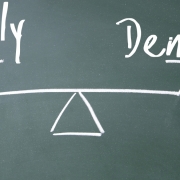Say’s Law, as explicated by the great liberal political economist Jean-Baptiste Say (1767-1832), is the principle that supply constitutes demand, with the corollary that aggregate supply always equals aggregate demand. There’s no more important principle in political economy to get perfectly right – and assiduously avoid getting wrong – than Say’s Law.
Say’s Law is the most important first principle in economics, with innumerable important corollaries and implications; its logic is irrefutable, its empirics undeniable. Any economist who denies the Law is akin to a physicist who denies the Law of Gravity; an economist opposed to Say’s Law isn’t really an economist, any more than a gravity denier is a true physicist.
Among the many important implications of Say’s Law is that prosperity and economic expansions are supply-side phenomena, a consequence of entrepreneurs, the profit motive, saving, investment and capital accumulation. Put negatively, “consumers” per se don’t drive economies (least of all, today’s largest consumer: government). Recessions, economic stagnation, unemployment, and crises occur not because of “over-production” (or “under-consumption”) but because public policies undermine property rights, manipulate prices, prevent markets from clearing, impede trade, and punitively tax profits, income, and capital.
Tragically, Say’s Law has been denied by John Maynard Keynes (1883-1946) and the Keynesians who dominated economics for at least four decades after World War II (and to some extent still influence economics and policymaking today). In his 1936 text, Keynes falsely attributed the Great Depression and mass unemployment to a prior period of “over-production” (in the 1920s). “Say’s Law,” he wrote, the principle “that the aggregate demand price of output as a whole is equal to its aggregate supply price for all volumes of output, is equivalent to the proposition that there is no obstacle to full employment.” (emphasis added) It was a preposterous claim.
In fact, Say’s Law reveals that while certain markets (say, the labor market) may be in disequilibrium, it’s not possible that all markets in aggregate can be so – and if, as with unemployed labor, supply exceeds demand, it’s due to policy barriers like minimum wage mandates, regulations and taxes on would-be employers and employees alike.
Although Keynesian economics dominated academia and policymaking from 1945 to 1980, beginning in the mid-1970s it was increasingly discredited as illogical in theory and harmful in practice; its macroeconomics was inherently contradictory, it had no foundation in microeconomics and it was harmful, precisely to the extent practiced, to economies in Britain, America, and India. Keynesian premises and policies ensured that the 1970s were marked by “stagflation – the worst of both worlds. Thankfully, this dire period was followed by New Classical Macroeconomics, “rational expectations” insights, and supply-side policy cures, all of which affirmed and built on the truth of Say’s Law and its corollaries. The world thereafter was made better by Saysian economics displacing (at least partly) Keynesian economics.
But Keynesian economics persists today, partly because it satisfies unwarranted suspicions that capitalism is inherently unstable or unsustainable, and partly because it rationalizes government policy intervention and activism. Many economists and policymakers, observing the financial-economic debacle of 2008-09, blithely assumed that Keynesian theory explained it while Keynesian policy could cure it.
Nothing was further from the truth. That debacle was caused not by capitalism (or “deregulation”) but by its contravention – by government subsidies, guarantees, and regulations in housing, banking, and mortgages – and it was worsened and prolonged to the extent Keynesian policies were adopted (e.g., massive new public spending and money issuance, plus a deliberate policy of near-zero interest rates).
The latest issue of the Review of Keynesian Economics is devoted entirely to a dozen Keynesian economists insisting strenuously that Keynesian economics is alive and well. No counterviews are entertained, but it seems the acolytes doth protest too much. Why the defensiveness? Because most Keynesian principles are false – always were, always will be. Yet today’s defensive acolytes can take comfort in the fact that Keynesian premises, no matter how wrong, will always retain a sympathetic hearing to the extent people are suspicious of capitalism, while Keynesian policies, no matter how wrong, will always win ardent support from policymakers to the extent they seek to rationalize interventionism and activism.
Say’s Law and Saysian economics go hand in hand with a political-economic-philosophical appreciation for capitalism – for rationality, the pursuit of self-interest, entrepreneurialism, profit-making, private property rights, the rule of law, and constitutionalism. Say’s Law was largely unquestioned (but also not fully grasped) in the century or so before Keynes tried to slay it in the 1930s; before then, Malthus, Rodbertus, and Marx were its most prominent deniers. We should be grateful that in recent years many scholars have kept Say’s political economy, his treatise, and his Law alive, well, and pertinent to contemporary debates – especially Steven Kates, James Ahiakpor, Alain Beraud, Richard Ebeling, Evelyn Forget, Steve Hanke, Steven Horwitz, Gilles Jacoud, Petur Jonsson, Guy Numa, Munir Quddus, Rashid Salim, Evert Schoorl, and Mark Skousen.
Given Say’s Law’s crucial importance to sound political economy and public policy, I offer the following concise account of it, together with its primary principles and propositions:
- Say’s Law holds that supply constitutes demand (not “supply creates its own demand”), with the crucial corollary that aggregate supply always equals aggregate demand. There can never be a deficiency (or excess) of aggregate demand relative to aggregate supply; the two phenomena are the same thing (or “two sides of the same coin”) viewed from different sides.
- It’s misleading to define Say’s Law as “supply creates its own demand” (or, so goes a typical ridicule, that supplying bikinis will create a demand for bikinis, even in Alaska). In truth, newly created bikinis entail a demand for things other thanbikinis. There can be a “glut” (surplus) of goods (or money) in some markets (microeconomic), but no “general glut” in all markets (macroeconomic), and to deny this is to commit the fallacy of composition (“what’s true of the parts is true of the whole”).
- Production is the creation of wealth (utility) and spending is the exchange of wealth while questions about who earns wealth (and how much – and why) pertain to the distribution of wealth; the consumption of wealth is not equivalent to demand but to the destruction of wealth (utility), the opposite of creating it (production). Demand is not equivalent to consumption; it’s a desire to purchase plus purchasing power (and the latter comes only from the creation of supply, or from the income one is paid for doing so). One cannot demand unless one first supplies(produces) something of value for offer to others in exchange for their goods. Markets are made by producers, not by consumers qua consumers (because consumption is the destruction of wealth, or utility).
- Of course, we produce wealth, ultimately, to consume it, or save-invest it, but this doesn’t mean consumption “causes” production (destruction is the opposite of creation). Obviously, some wealth is consumed in the process of creating wealth (see “cost of goods sold” in profit-loss statements), but no (net) wealth is truly created unless there’s valued-added (sales exceeding costs = profit). Profit isn’t a “deduction” from (labor) income but net production.
- Sound economics focuses on the production, exchange and distribution of wealth, not on its consumption; there is a “primacy of production” – because supply is a necessary precondition for prosperity, wealth creation, and demand. Given the importance and primacy of production in an advancing, progressing civilization, we must be concerned above all with the freedom, rights, incentives, and rewards of creative inventors, engineers, and entrepreneurs.
- Says’ Law is as true in an advanced, monetary economy as it is in a barter economy, and as true in the short term as it is over the long term; in this way Say’s Law doesn’t differ from the law of gravity. These two aspects of Say’s Law are often misunderstood even by adherents.
- When we produce things in exchange for money or income, we demand money (and income), for purposes of spending or saving; but saving is not a “leakage” from “the spending stream” (it is saved wealth and invested, which means: spending on capital goods instead of spending on consumer goods). If money is hoarded, no drop in total demand occurs; money itself is a type of good, and if hoarded, is itself demanded (intensely so). A “scarcity” of money by itself doesn’t impede output growth; it merely entails a declining price level; but this should be welcomed as “a declining cost of living” (which implies a rising standard of living). Money hoarding isn’t a normal part of a free economy but occurs when public policy is confiscatory and/or risk-promoting; to the extent a higher, intense demand for money (hoarding) accompanies economic stagnation it’s due to bad policy, not to relatively less total demand.
- Economic recessions reflect not insufficient nominal demand (an alleged “money shortage”) but less real supply due to counter-productive public policies (taxing, regulating, etc.) which seize or divert wealth and impede-punish its creation; government spending doesn’t cure recessions by promoting consumption but only delays recovery; public spending is financed by taxes, borrowing, or money-printing, none of which is, per se, pro-production; no magical “public spending multiplier” arises from some increased “marginal propensity to consume.”
- Keynes’s claim that Say’s Law is “equivalent to the proposition that there is no obstacle to full employment [of labor]” is patently false; many (non-macro) factors impede full employment, including above-market wage rates (whether imposed by coercive unions or public policies) and the punitive taxation and/or regulations inflicted on would-be employers and employees.
- Some Keynesians have acknowledged the importance of a debate about foundations and first principles, conceding that if Say’s Law is true, Keynesian economics necessarily cannot also be true(since the latter says a differential can arise between aggregate demand and aggregate supply and that government policy can do something to close the differential). By the logic and reality of the matter, Say’s Law in fact is true and valid, so Keynesian economics is not.
The great French liberal Frederic Bastiat (1801-1850) popularized much of Say’s political economy and in his Economic Harmonies(1848) wrote of Say and Say’s Law as follows:
It is fortunate for society that men of genius like Say have patiently and tirelessly applied themselves to observing, classifying, and setting down methodically all the facts that constitute this excellent science [of political economy]. Henceforth the human mind can move forward from this firm base toward new horizons. . . You too might be able to take this same torch from the hands of your predecessors and turn its light upon some of the dark recesses of the social sciences, and particularly upon those that have recently been plunged into darkness by the dissemination of mad doctrines.
It’s worth reiterating that there’s no more important principle in political economy to get right – and avoid getting wrong – than Say’s Law. As Bastiat knew, the Law is akin to a torch illuminating and facilitating the spread of knowledge, based on reason and reality. It also helps us avoid a deleterious dissent into the darkness of “mad doctrines.”
AIER Senior Fellow Richard M. Salsman is president of InterMarket Forecasting, Inc. and a visiting assistant professor of political economy at Duke University.













